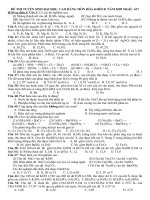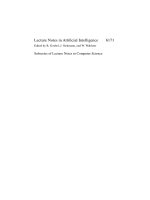IT training NSHipster obscure topics in cocoa objective c thompson 2013 11 12
Bạn đang xem bản rút gọn của tài liệu. Xem và tải ngay bản đầy đủ của tài liệu tại đây (6.82 MB, 0 trang )
first edition
nshipster
NS
obscure topics
in cocoa &
objective-c
mattt thompson
!
Mattt Thompson
NSHipster: Obscure
Topics In Cocoa &
Objective-C
!
!
!
!
!
!
!
!
!
!
!
!
Copyright © 2013 Mattt Thompson
All rights reserved
Illustrated by Conor Heelan
ISBN 978-0-9912182-1-9
NSHipster
Portland, Oregon
Table of Contents
Objective-C
10
#pragma
11
nil / Nil /
NULL / NSNull
16
BOOL / bool /
Boolean / NSCFBoolean
20
Equality
24
Type Encodings
35
C Storage Classes
41
@
47
__attribute__
61
instancetype
71
NS_ENUM &
NS_OPTIONS
74
Foundation &
CoreFoundation
79
Key-Value Coding
Collection Operators
80
Key-Value Observing
86
NSError
99
NSOperation
108
NSSortDescriptor
115
NSPredicate
120
NSExpression
133
NSFileManager
141
NSValue
153
NSValueTransformer
156
NSDataDetector
160
CFBag
166
NSCache
171
NSIndexSet
174
NSOrderedSet
176
NSHashTable &
NSMapTable
181
UIKit
188
UIMenuController
189
UILocalizedIndexedCollation
197
UIAppearance
204
Localization,
Internationalization &
Accessibility
209
NSLocale
210
NSLocalizedString
217
UIAccessibility
222
NSFormatter
232
CFStringTransform
241
NSLinguisticTagger
246
API Design
254
The Law of Demeter
255
The Principle of
Least Surprise
265
Naming
269
Community
273
Stewardship
274
Empathy
284
Introduction
To be an NSHipster is to care deeply about the craft of writing
code. In cultivating a deep understanding and appreciation of
Objective-C, its frameworks and ecosystem, one is able to
create apps that delight and inspire users.
This book takes a structured approach to learning ObjectiveC development, starting from the language and system
frameworks, and moving onto high-level concerns, like
internationalization, design, and community. It is as much a
technical manual as it is a meditation on the practice of
coding.
I hope that by reading this, you will share in the excitement of
discovering new insights, and taking pride in your work.
9
Objective-C
!
10
#pragma
#pragma declarations are a mark of craftsmanship in
Objective-C. Although originally used to make source code
portable across different compilers, the Xcode-savvy coder
uses #pragma declarations to very different ends.
In this modern context, #pragma skirts the line between
comment and code. As a preprocessor directive, #pragma
evaluates at compile-time, but unlike other macros, #pragma
is not used to change the runtime behavior of an application.
Instead, #pragma declarations are used by Xcode to
accomplish two primary tasks: organizing code and inhibiting
compiler warnings.
Organizing Your Code
Code organization is a matter of hygiene. How you structure
your code is a reflection on you and your work. A lack of
convention and internal consistency indicates either
carelessness or incompetence—and worse, makes a project
difficult to maintain and collaborate on.
11
Good habits start with #pragma mark:
@implementation ViewController
- (id)init {
...
}
#pragma mark - UIViewController
- (void)viewDidLoad {
...
}
#pragma mark - IBAction
- (IBAction)cancel:(id)sender {
...
}
#pragma mark - UITableViewDataSource
- (NSInteger)tableView:(UITableView *)tableView
numberOfRowsInSection:(NSInteger)section
{
}
#pragma mark - UITableViewDelegate
- (void)tableView:(UITableView *)tableView
didSelectRowAtIndexPath:(NSIndexPath *)indexPath {
...
}
Use #pragma mark in your @implementation to divide code
into logical sections. Not only do these sections make it easier
to read through the code itself, but it also adds visual cues to
the Xcode source navigator.
12
#pragma mark declarations starting with a dash (-) are preceded
with a horizontal divider.
Start by grouping methods according to their originating
class. For example, an NSInputStream subclass would have a
group marked NSInputStream, followed by a group marked
NSStream.
Things like IBAction outlets, or methods corresponding to
target / action, notification, or KVO selectors probably
deserve their own sections as well.
Finally, if a class conforms to any @protocols, group all of the
methods from each protocol together, and add a #pragma
mark header with the name of that protocol.
Your code should be clean enough to eat off of. So take the
time to leave your .m files better than how you found them.
Inhibiting Warnings
What's even more annoying than poorly-formatted code?
Code that generates warnings. Especially 3rd-party code.
There are few things as irksome as that one vendor library that
takes forever to compile, and finishes with 200+ warnings.
Even shipping code with a single warning is in poor form.
13
Try setting the -Weverything flag and checking the "Treat Warnings
as Errors" box your build settings.
This turns on Hard Mode in Xcode.
But sometimes there's no avoiding compiler warnings.
Deprecation notices and retain-cycle false positives are two
common examples where this might happen. In those rare
cases where you are absolutely certain that a particular
compiler warning should be inhibited, #pragma can be used
to suppress them:
#pragma clang diagnostic push
#pragma clang diagnostic ignored "-Wunused-variable"
OSStatus status = SecItemExport(...);
NSCAssert(status == errSecSuccess, @"%d", status);
#pragma clang diagnostic pop
This code sample is an example of an otherwise unavoidable
warning from the static analyzer. When compiling in Release
mode, assertions are ignored, so Clang warns that status is an
unused variable.
Using #pragma clang diagnostic push/pop, you can tell the
compiler to ignore certain warnings for a particular section of
code (the original diagnostic settings are restored with the
final pop).
Just don't use #pragma as a way to sweep legitimate warnings
under the rug—it will only come back to bite you later.
14
You can read more about the LLVM's use of #pragma in the Clang
Compiler User's Manual.
Like a thrift store 8-track player turned into that lamp in the
foyer, #pragma remains a curious vestige of the past: Once the
secret language of compilers, it is now re-purposed to bettercommunicate intent to other programmers.
How delightfully vintage!
15
nil / Nil /
NULL / NSNull
Understanding the concept of nothingness is as much a
philosophical issue as it is a pragmatic one. We are inhabitants
of a universe made up of somethings, yet reason in a logical
universe with existential uncertainties. As a physical
manifestation of a logical system, computers are faced with
the intractable problem of how to represent nothing with
something.
In Objective-C, there are several different varieties of nothing.
C represents nothing as 0 for primitive values, and NULL for
pointers (which is equivalent to 0 in a pointer context).
Objective-C builds on C's representation of nothing by
adding nil. nil is an object pointer to nothing. Although
semantically distinct from NULL, they are equivalent to one
another.
16
On the framework level, Foundation defines the NSNull class,
which defines a single class method, +null, which returns a
singleton NSNull instance. NSNull is different from nil or
NULL, in that it is an actual object, rather than a zero value.
Additionally, in Foundation/NSObjCRuntime.h, Nil is
defined as a class pointer to nothing. This lesser-known titlecase cousin of nil doesn't show up much very often, but it's at
least worth noting.
There's Something About nil
Newly-alloc'd NSObjects start life with their contents set to 0.
This means that all pointers an object has to other objects
begin as nil, so it's unnecessary to, for instance, set
self.association = nil in init methods.
Perhaps the most notable behavior of nil, though, is that it
handles messages sent to it.
In other languages, like C++, sending a message to a null
pointer would crash a program, but in Objective-C, invoking
a method on nil returns a zero value. This greatly simplifies
expressions, as it obviates the need to check for nil before
doing anything:
17
// For example, this expression...
if (name != nil && [name isEqualToString:@"Steve"])
{ ... }
!
// ...can be simplified to:
if ([name isEqualToString:@"steve"]) { ... }
Being aware of how nil works in Objective-C allows this
convenience to be a feature, rather than a source of hard-tofind bugs.
Guard against cases where nil values are unwanted, either by
returning early, or adding a NSParameterAssert to throw an
exception.
NSNull: Something for Nothing
NSNull is used throughout Foundation and other system
frameworks to skirt around the limitations of collections like
NSArray and NSDictionary, which cannot contain nil values.
NSNull effectively boxes NULL or nil values, so that they can
be stored in collections:
18
NSMutableDictionary *mutableDictionary =
[NSMutableDictionary dictionary];
!
mutableDictionary[@"someKey"] = [NSNull null];
// Sets value of NSNull singleton for `someKey`
!
NSLog(@"Keys: %@", [mutableDictionary allKeys]);
// @[@"someKey"]
!
So to recap, here are the four values representing nothing that
every Objective-C programmer should know about:
Symbol
Value
Meaning
NULL
(void *)0
literal null value for C pointers
nil
(id)0
literal null value for Objective-C objects
Nil
(Class)0
literal null value for Objective-C classes
NSNull
[NSNull null] singleton object used to represent null
19
BOOL / bool /
Boolean /
NSCFBoolean
Truth, Vēritās: The entire charter of Philosophy is founded
upon the pursuit of it, and yet its exact meaning and
implications still elude us.
Does truth exist independently, or is it defined contingently?
Can a proposition be at once both true and false?
Is there absolute truth in anything, or is everything relative?
Once again, encoding our logical universe into the cold,
calculating bytecode of computers forces us to deal with these
questions one way or another. And as you'll see from our
discussion of boolean types in C & Objective-C, truth is
indeed stranger than fiction.
Objective-C defines BOOL to encode truth value. It is a
typedef of a signed char, with the macros YES and NO to
represent true and false, respectively.
20
Boolean values are used in conditionals, such as if or while
statements, to conditionally perform logic or repeat
execution. When evaluating a conditional statement, the value
0 is considered "false", while any other value is considered
"true". Because NULL and nil have a value of 0, they are
considered "false" as well.
In Objective-C, use the BOOL type for parameters,
properties, and instance variables dealing with truth values.
When assigning literal values, use the YES and NO macros.
The Wrong Answer to the Wrong Question
Novice programmers often include an equality operator when
evaluating conditionals:
if ([a isEqual:b] == YES) { ... }
Not only is this unnecessary, but depending on the left-hand
value, it may also lead to unexpected results. Consider this
function, which returns whether two integers are different:
static BOOL different (int a, int b) {
return a - b;
}
A programmer might take some satisfaction in the clever
simplicity of this approach: indeed, two integers are equal if
and only if their difference is 0.
21
However, because BOOL is typedef 'd as a signed char on 32bit architectures, this will not behave as expected:
different(11, 10) // YES
different(10, 11) // NO (!)
different(512, 256) // NO (!)
Now, this might be acceptable for JavaScript, but Objective-C
don't suffer fools gladly.
On a 64-bit iOS, BOOL is defined as a bool, rather than signed char,
which precludes the runtime from these type conversion errors.
Deriving truth value directly from an arithmetic
operation is never a good idea. Use the == operator, or cast
values into booleans with the ! (or !!) operator.
The Truth About NSNumber and BOOL
Pop quiz: what is the output of the following expression?
NSLog(@"%@", [@(YES) class]);
The answer:
__NSCFBoolean
Wait, what?
22
All this time, we've been led to believe that NSNumber boxes
primitives into an object representation. Any other integer or
float derived NSNumber object shows its class to be
__NSCFNumber. What gives?
NSCFBoolean is a private class in the NSNumber class cluster.
It is a bridge to the CFBooleanRef type, which is used to wrap
boolean values for Core Foundation collections and property
lists. CFBoolean defines the constants kCFBooleanTrue and
kCFBooleanFalse. Because CFNumberRef and
CFBooleanRef are different types in Core Foundation, it
makes sense that they are represented by different bridging
classes in NSNumber.
!
Wrapping things up, here is a table with the truth types and
values in Objective-C:
Name
Type
Header
True
False
BOOL
signed char / bool
objc.h
YES
NO
bool
_Bool (int)
stdbool.h
TRUE
FALSE
Boolean
unsigned char
MacTypes.h
TRUE
FALSE
NSNumber
__NSCFBoolean
Foundation.h
@(YES) @(NO)
23
Equality
The concept of equality is a central point of debate and
inquiry in philosophy and mathematics, with far-reaching
implications for matters of ethics, justice, and public policy.
From an empiricist perspective of the universe, two objects
are equal if they are indistinguishable from one another in
measurable observations. Egalitarians, operating on a human
scale, hold that individuals should be considered equal
members of the societal, economic, political, and judicial
systems they inhabit.
It is the task of programmers to reconcile our logical and
physical understanding of equality with the semantic
domains we model.
Equality & Identity
First and foremost, it is important to make a distinction
between equality and identity.
24
Two objects may be equal or equivalent to one another, if they
share a common set of properties. Yet, those two objects may
still be thought to be distinct, each with their own identity.
In code, an object's identity is tied to its memory address.
NSObject tests equality with another object with the method
isEqual:. In its base implementation, an equality check is
essentially a test for identity:
@implementation NSObject (Approximate)
- (BOOL)isEqual:(id)object {
return self == object;
}
@end
isEqual
Subclasses of NSObject implementing their own isEqual:
method are expected to do the following:
• Implement a new isEqualToClassName: method, which
performs the meaningful value comparison.
• Override isEqual: to make class and object identity checks,
falling back on the aforementioned class comparison
method.
• Override hash, which will be described in the next section.
25









